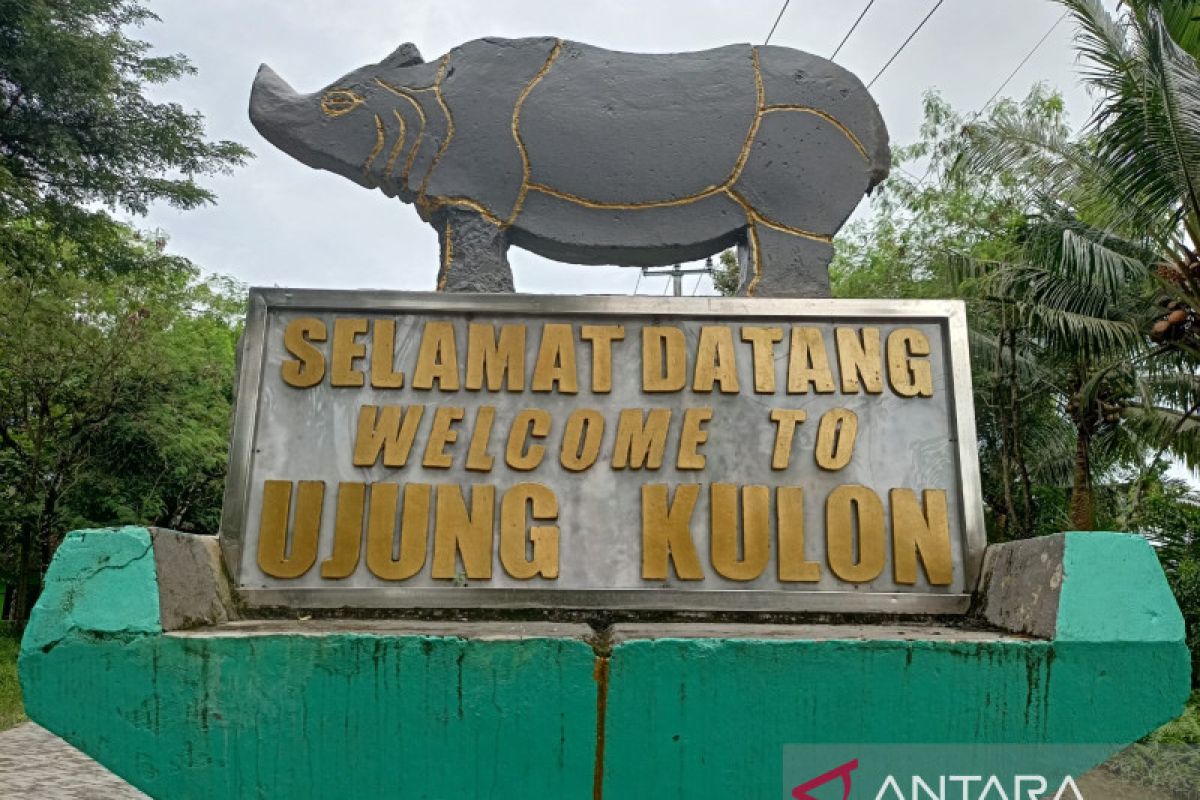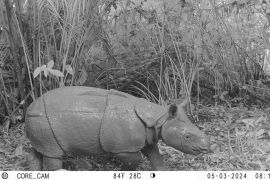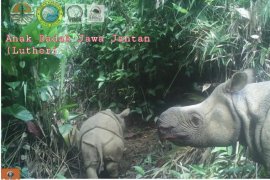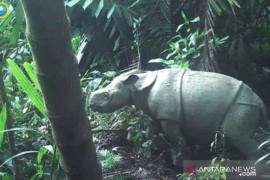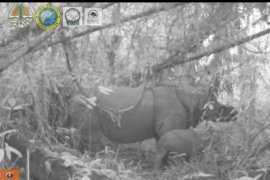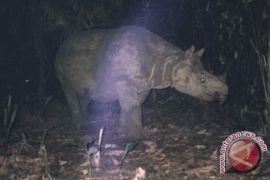One eventful day in November 2017, he and one of his coworkers were in the middle of a routine patrol when he spotted a male rhino eating. It was the first time he saw the rhino. Till then, despite having traversed the area, and going back and forth from the forest, he had only found signs pointing to its existence, such as footprints and dirt, but never once set sight on its true form.
Upon encountering the rhino, Syamsudin was overcome with several conflicting feelings, of happiness and fear—all joined together. He immediately took his phone and recorded the rhino's activity. Initially, he thought that it would not run after him, so he slowly began to creep toward the animal. But suddenly, it noticed his presence and gave chase.
Luckily, Syamsudin was saved by a weeping fig, which bore the brunt of the rhino’s assault. It was a close shave: When the rhino struck the tree, Syamsudin and the rhino were just a meter apart. Afterward, the rhino made its way back to the forest.
"If I was poked by its horn or got hit, I would surely be in critical condition, I could have died. But I received a bit of token of remembrance, that being a bump on the head from rhino spit. It gives headache and pain, turns out," he said in Ujung Kulon National Park, Banten.
As time passed, the bump grew larger. Though it should have been surgically removed, Syamsudin preferred not to, seeing it as a mark from the rhino.
Sasmita, a man from Ujungjaya Village, has a different experience to relate given his two-decades-old ties with rhinos.
Prior to devoting his time as a freelancer at the national park, he hunted swiftlet nests and honey to be sold in Jakarta and surrounding areas. Due to his profession, he gained the ability to map the location of national parks, which enabled him to avoid the paths used by the Javan rhino.
"Because we used to have no income. Jobs in Ujung Kulon are farming, seafaring, or going to the forest," Sasmita said.
His expertise in mapping the national park's paths attracted the interest of World Wildlife Fund (WWF) officials, leading them to recruit him. The organization gave him the task of installing camera traps. His skills grew after the scientists taught him how to determine the rhinos' age based on their footprints.
Officials at Ujung Kulon National Park also noticed his skills. And ever since, he has devoted himself to rhino conservation efforts. Prior to joining either the WWF or the national park, he had never once seen a rhino, despite often being in the forest. All he knew was the puddle in which they bathed, their footprints, and their dirt.
His first meeting with a rhino happened when he accompanied some scientists to install a camera trap. While setting the camera, he did not realize that there was a rhino peeking behind the dense layers of the forest.
Its snort startled him, causing him to immediately hide behind a tree, away from its hit since it can rip through the skin.
However, his experience did not make him back down in fear. Instead, he felt his attachment to Rhinoceros sondaicus growing more intense.
Sasmita is now trusted as the coordinator of camera trap installation, along with 30 other residents of Ujungjaya village. Interestingly, they all used to earlier enter the conservation forest illegally.
Related news: Ujungkulon Park records increase in Javanese rhino population
Community involvement
According to head of the management section of the National Park Region II Handeuleum at Ujung Kulon National Park, Ujang Acep, community involvement in conservation efforts is vital for saving the Javan rhino from the threat of extinction.
Acep said that without community involvement, efforts to save the Javan rhinoceros would come to nothing. Surrounding engagement can minimize threats while increasing security.
Community involvement has been on for more than two decades, with recruits often belonging to communities who have spent quite some time exploring the forest. Their experience comes in handy for the Ujung Kulon National Park Center in finding traces, and puddles, installing camera traps, and looking after other conservation needs.
There are more than 30 local residents who are now part of the Javan Rhino Monitoring Team at the Ujung Kulon National Park Center. They have been divided into several groups according to their abilities. Among them are patrol members, camera trap installers, rhino feed sowing and surveillance teams, to units that monitor rhino health.
Every 15 days of each month, they take turns entering the main zone. If there is no agenda in the forest, the community is allowed to pursue other activities, like farming and serving as porters for researchers and pilgrims going to the Sanghiyang Sirah area.
Although they have plenty of members, they have also often experienced problems. Since the majority are farmers, no one wants to go into the forest when the harvest season is on. Thus, the identification and evaluation of camera traps have to be put on hold until the harvest season ends.
"When harvesting, everyone refuses to enter the forest even although they are paid more. This is an issue as well as a unique thing for me," Acep remarked in a thick Sundanese accent.
Related news: Indonesia committed to land rehabilitation and conservation: official
Legend
The Javan rhinoceros is one forest dweller that is very difficult to spot. On top of their living in the depths of the forest, there are only a few rhinos left. Even some people in Tamanjaya and Ujungjaya villages, which border the national park, have thought of the Javan rhinoceros as a legend.
No one has really seen the rhino. They only know of the appearance of the Javan rhino from television shows and word of mouth. But to them, rhinos are like givers of life.
"The Javan rhino for the Tamanjaya community is not only limited to animals. We get a livelihood, because we can go to sea, pursue tourism. The point is that the rhino has given us sustenance," Tamanjaya village secretary Samsuri said.
Samsuri feels that if the Javan rhino goes extinct, there will be no more animals to be proud of, to be shared with their children and grandchildren in the future.
For the people of Ujung Kulon, the Javan rhino is an animal that symbolizes their pride, and thus, needs to be saved. In the midst of rescue efforts, it is not uncommon for them to risk their lives to protect the rhinos from extinction.
Syamsudin and Sasmita's tales are a snapshot of their involvement in getting along with the Javan rhino. Often they have to travel tens of kilometers in the forest, or camp for days, just to assist in conservation efforts.
For them, the rhino is not only a rare animal, but a source of life—because physical encounters are essentially an exchange of love.
Related news: Two baby Javan rhinos born in Banten's Ujung Kulon National Park: govt
Related news: 40 Sumatran rhinos in Way Kambas National Park
Editor: Suharto
Copyright © ANTARA 2022
